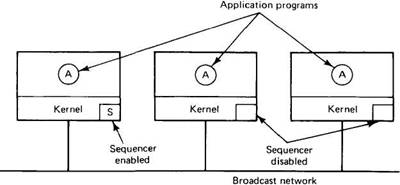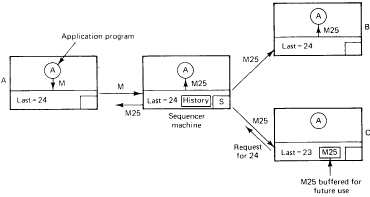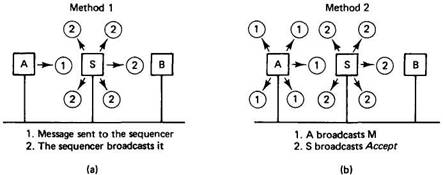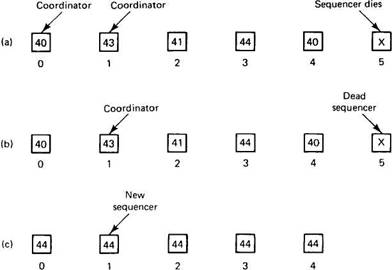Книга: Distributed operating systems
7.5.2. Group Communication in Amoeba
Разделы на этой странице:
7.5.2. Group Communication in Amoeba
RPC is not the only form of communication supported by Amoeba. It also supports group communication. A group in Amoeba consists of one or more processes that are cooperating to carry out some task or provide some service. Processes can be members of several groups at the same time. Groups are closed, meaning that only members can broadcast to the group. The usual way for a client to access a service provided by a group is to do an RPC with one of its members. That member then uses group communication within the group, if necessary, to determine who will do what.
This design was chosen to provide a greater degree of transparency than an open group structure would have. The idea behind it is that clients normally use RPC to talk to individual servers, so they should use RPC to talk to groups as well. The alternative — open groups and using RPC to talk to single servers but using group communication to talk to group servers — is much less transparent. (Using group communication for everything would eliminate the many advantages of RPC that we have discussed earlier.) Once it has been determined that clients outside a group will use RPC to talk to the group (actually, to talk to one process in the group), the need for open groups vanishes, so closed groups, which are easier to implement, are adequate.
The operations available for group communication in Amoeba are listed in Fig. 7-10. CreateGroup creates a new group and returns a group identifier used in the other calls to identify which group is meant. The parameters specify various sizes and how much fault tolerance is required (how many dead members the group must be able to withstand and continue to function correctly).
| Call | Description |
|---|---|
| CreateGroup | Create a new group and set its parameters |
| JoinGroup | Make the caller a member of a group |
| LeaveGroup | Remove the caller from a group |
| SendToGroup | Reliably send a message to all members of a group |
| ReceiveFromGroup | Block until a message arrives from a group |
| ResetGroup | Initiate recovery after a process crash |
Fig. 7-10. Amoeba group communication primitives.
JoinGroup and LeaveGroup allow processes to enter and exit from existing groups. One of the parameters of JoinGroup is a small message that is sent to all group members to announce the presence of a newcomer. Similarly, one of the parameters of LeaveGroup is another small message sent to all members to say goodbye and wish them good luck in their future activities. The point of the little messages is to make it possible for all members to know who their comrades are, in case they are interested, for example, to reconstruct the group if some members crash. When the last member of a group calls LeaveGroup, it turns out the lights and the group is destroyed.
SendToGroup atomically broadcasts a message to all members of a specified group, in spite of lost messages, finite buffers, and processor crashes. Amoeba supports global time ordering, so if two processes call SendToGroup simultaneously, the system ensures that all group members will receive the messages in the same order. This is guaranteed; programmers can count on it. If the two calls are exactly simultaneous, the first one to get its packet onto the LAN successfully is declared to be first. In terms of the semantics discussed in Chap. 6, this model corresponds to sequential consistency, not strict consistency.
ReceiveFromGroup tries to get a message from a group specified by one of its parameter. If no message is available (that is, currently buffered by the kernel), the caller blocks until one is available. If a message has already arrived, the caller gets the message with no delay. The protocol ensures that in the absence of processor crashes, no messages are irretrievably lost. The protocol can also be made to tolerate crashes, at the cost of additional overhead, as discussed later.
The final call, ResetGroup, is used to recover from crashes. It specifies how many members the new group must have as a minimum. If the kernel is able to establish contact with the requisite number of processes and rebuild the group, it returns the size of the new group. Otherwise, it fails. In this case, recovery is up to the user program.
The Amoeba Reliable Broadcast Protocol
Let us now look at how Amoeba implements group communication. Amoeba works best on LANs that support either multicasting or broadcasting (or like Ethernet, both). For simplicity, we will just refer to broadcasting, although in fact the implementation uses multicasting when it can to avoid disturbing machines that are not interested in the message being sent. It is assumed that the hardware broadcast is good, but not perfect. In practice, lost packets are rare, but receiver overruns do happen occasionally. Since these errors can occur they cannot simply be ignored, so the protocol has been designed to deal with them.
The key idea that forms the basis of the implementation of group communication is reliable broadcasting. By this we mean that when a user process broadcasts a message (e.g., with SendToGroup) the user-supplied message is delivered correctly to all members of the group, even though the hardware may lose packets. For simplicity, we will assume that each message fits into a single packet. For the moment, we will assume that processors do not crash. We will consider the case of unreliable processors afterward. The description given below is just an outline. For more details, see (Kaashoek and Tanenbaum, 1991; and Kaashoek et al., 1989). Other reliable broadcast protocols are discussed in (Birman and Joseph, 1987a; Chang and Maxemchuk, 1984; Garcia-Molina and Spauster, 1991; Luan and Gligor, 1990; Melliar-Smith et al., 1990; and Tseung, 1989).
The hardware/software configuration required for reliable broadcasting in Amoeba is shown in Fig. 7-11. The hardware of all the machines is normally identical, and they all run exactly the same kernel. However, when the application starts up, one of the machines is elected as sequencer (like a committee electing a chairman). If the sequencer machine subsequently crashes, the remaining members elect a new one. Many election algorithms are known, such as choosing the process with the highest network address. We will discuss fault tolerance later in this chapter.

Fig. 7-11. System structure for group communication in Amoeba.
One sequence of events that can be used to achieve reliable broadcasting can be summarized as follows.
1. The user process traps to the kernel, passing it the message.
2. The kernel accepts the message and blocks the user process.
3. The kernel sends a point-to-point message to the sequencer.
4. When the sequencer gets the message, it allocates the next available sequence number, puts the sequence number in a header field reserved for it, and broadcasts the message (and sequence number).
5. When the sending kernel sees the broadcast message, it unblocks the calling process to let it continue execution.
Let us now consider these steps in more detail. When an application process executes a broadcasting primitive, such as SendToGroup, a trap to its kernel occurs. The kernel then blocks the caller and builds a message containing a kernel-supplied header and the application-supplied data. The header contains the message type (Request for Broadcast in this case), a unique message identifier (used to detect duplicates), the number of the last broadcast received by the kernel (usually called a piggybacked acknowledgement), and some other information.
The kernel sends the message to the sequencer using a normal point-to-point message, and simultaneously starts a timer. If the broadcast comes back before the timer runs out (normal case), the sending kernel stops the timer and returns control to the caller. In practice, this case happens well over 99 percent of the time, because modern LANs are highly reliable.
On the other hand, if the broadcast has not come back before the timer expires, the kernel assumes that either the message or the broadcast has been lost. Either way, it retransmits the message. If the original message was lost, no harm has been done, and the second (or subsequent) attempt will trigger the broadcast in the usual way. If the message got to the sequencer and was broadcast, but the sender missed the broadcast, the sequencer will detect the retransmission as a duplicate (from the message identifier) and just tell the sender that everything is all right. The message is not broadcast a second time.
A third possibility is that a broadcast comes back before the timer runs out, but it is the wrong broadcast. This situation arises when two processes attempt to broadcast simultaneously. One of them, A, gets to the sequencer first, and its message is broadcast. A sees the broadcast and unblocks its application program. However its competitor, B, sees A's broadcast and realizes that it has failed to go first. Nevertheless, B knows that its message probably got to the sequencer (since lost messages are rare), where it will be queued and broadcast next. Thus B accepts A's broadcast and continues to wait for its own broadcast to come back or its timer to expire.
Now consider what happens at the sequencer when a Request for Broadcast arrives there. First a check is made to see if the message is a retransmission, and if so, the sender is informed that the broadcast has already been done, as mentioned above. If the message is new (normal case), the next sequence number is assigned to it, and the sequencer counter incremented by 1 for next time. The message and its identifier are then stored in a history buffer, and the message is then broadcast. The message is also passed to the application running on the sequencer's machine (because the broadcast does not cause an interrupt on the machine that issued the broadcast).
Finally, let us consider what happens when a kernel receives a broadcast. First, the sequence number is compared to the sequence number of the broadcast received most recently. If the new one is 1 higher (normal case), no broadcasts have been missed, so the message is passed up to the application program, assuming that it is waiting. If it is not waiting, it is buffered until the program calls ReceiveFromGroup.
Suppose that the newly received broadcast has sequence number 25, while the previous one had number 23. The kernel is immediately alerted to the fact that it has missed number 24, so it sends a point-to-point message to the sequencer asking for a private retransmission of the missing message. The sequencer fetches the missing message from its history buffer and sends it. When it arrives, the receiving kernel processes 24 and 25, passing them to the application program in numerical order. Thus the only effect of a lost message is a (normally) minor time delay. All application programs see all broadcasts in the same order, even if some messages are lost.
The reliable broadcast protocol is illustrated in Fig. 7-12. Here the application program running on machine A passes a message, M, to its kernel for broadcasting. The kernel sends the message to the sequencer, where it is assigned sequence number 25. The message (containing the sequence number 25) is now broadcast to all machines and also passed to the application program running on the sequencer itself. This broadcast message is denoted by M25 in the figure.

Fig. 7-12. The application of machine A sends a message to the sequencer, which then adds a sequence number (25) and broadcasts it. At B it is accepted, but at C it is buffered until 24, which was missed, can be retrieved from the sequencer.
The M25 message arrives at machines B and C. At machine B the kernel sees that it has already processed all broadcasts up to and including 24, so it immediately passes M25 up to the application program. At C, however, the last message to arrive was 23 (24 must have been lost), so M25 is buffered in the kernel, and a point-to-point message requesting 24 is sent to the sequencer. Only after the reply has come back and been given to the application program will M25 be passed upward as well.
Now let us look at the management of the history buffer. Unless something is done to prevent it, the history buffer will quickly fill up. However, if the sequencer knows that all machines have received broadcasts, say, 0 through 23, correctly, it can delete these from its history buffer.
Several mechanisms are provided to allow the sequencer to discover this information. The basic one is that each Request for Broadcast message sent to the sequencer carries a piggybacked acknowledgement, k, meaning that all broadcasts up to and including k have been correctly received. This way, the sequencer can maintain a piggyback table, indexed by machine number, telling for each machine which broadcast was the last one received. Whenever the history buffer begins to fill up, the sequencer can make a pass through this table to find the smallest value. It can then safely discard all messages up to and including this value.
If one machine happens to be silent for an unusually long period of time, the sequencer will not know what its status is. To inform the sequencer, it is required to send a short acknowledgement message when it has sent no broadcast messages for a certain period of time. Furthermore, the sequencer can broadcast a Request for Status message, which directs all other machines to send it a message giving the number of the highest broadcast received in sequence. In this way, the sequencer can update its piggyback table and then truncate its history buffer.
Although in practice Request for Status messages are rare, they do occur, and thus raise the mean number of messages required for a reliable broadcast slightly above 2, even when there are no lost messages. The effect increases slightly as the number of machines grows.
There is a subtle design point concerning this protocol that should be clarified. There are two ways to do the broadcast. In method 1 (described above), the user sends a point-to-point message to the sequencer, which then broadcasts it. In method 2, the user broadcasts the message, including a unique identifier. When the sequencer sees this, it broadcasts a special Accept message containing the unique identifier and its newly assigned sequence number. A broadcast is "official" only when the Accept message has been sent. The two methods are compared in Fig. 7-13.

Fig. 7-13. Two methods for doing reliable broadcasting.
These protocols are logically equivalent, but they have different performance characteristics. In method 1, each message appears in full on the network twice: once to the sequencer and once from the sequencer. Thus a message of length m bytes consumes 2m bytes worth of network bandwidth. However, only the second of these is broadcast, so each user machine is interrupted only once (for the second message).
In method 2, the full message appears only once on the network, plus a very short Accept message from the sequencer, so only half the bandwidth is consumed. On the other hand, every machine is interrupted twice, once for the message and once for the Accept. Thus method 1 wastes bandwidth to reduce interrupts compared to method 2. Depending on the average message size, one may be preferable to the other.
In summary, this protocol allows reliable broadcasting to be done on an unreliable network in just over two messages per reliable broadcast. Each broadcast is indivisible, and all applications receive all messages in the same order, no matter how many are lost. The worst that can happen is that some delay is introduced when a message is lost, which rarely happens. If two processes attempt to broadcast at the same time, one of them will get to the sequencer first and win. The other will see a broadcast from its competitor coming back from the sequencer, and will realize that its request has been queued and will appear shortly, so it simply waits.
Fault-Tolerant Group Communication
So far we have assumed that no processors crash. In fact, this protocol has been designed to withstand the loss of an arbitrary collection of k processors (including the sequencer), where k (the resilience degree) is selected when the group is created. The larger k is, the more redundancy is required, and the slower the operation is in the normal case, so the user must choose k with care. We will sketch the recovery algorithm below. For more details, see (Kaashoek and Tanenbaum, 1991).
When a processor crashes, initially no one detects this event. Sooner or later, however, some kernel notices that messages sent to the crashed machine are not being acknowledged, so the kernel marks the crashed processor as dead and the group as unusable. All subsequent group communication primitives on that machine fail (return an error status) until the group has been reconstructed.
Shortly after noticing a problem, the user process getting the error return calls ResetGroup to initiate recovery. The recovery is done in two phases (Garcia-Molina, 1982). In phase one, one process is elected as coordinator. In phase two, the coordinator rebuilds the group and brings all the other processes up to date. At that point, normal operation continues.
In Fig. 7-14(a) we see a group of six machines, of which machine 5, the sequencer, has just crashed. The numbers in the boxes indicate the last message correctly received by each machine. Two machines, 0 and 1, detect the sequencer failure simultaneously, and both call ResetGroup to start recovery. This call results in the kernel sending a message to all other members inviting them to participate in the recovery and asking them to report back the sequence number of the highest message they have seen. At this point it is discovered that two processes have declared themselves coordinator. The one that has seen the message with the highest sequence number wins. In case of a tie, the one with the highest network address wins. This leads to a single coordinator, as shown in Fig. 7-14(b).

Fig. 7-14. (a) The sequencer crashes. (b) A coordinator is selected. (c) Recovery.
Once the coordinator has been voted into office, it collects from the other members any messages it may have missed. Now it is up to date and is able to become the new sequencer. It builds a Results message announcing itself as sequencer and telling the others what the highest sequence number is. Each member can now ask for any messages that it missed. When a member is up to date, it sends an acknowledgement back to the new sequencer. When the new sequencer has an acknowledgement from all the surviving members, it knows that all messages have been correctly delivered to the application programs in order, so it discards its history buffer, and normal operation can resume.
Another problem remains: How does the coordinator get any messages it has missed if the sequencer has crashed? The solution lies in the value of k, the resilience degree, chosen at group creation time. When k is 0 (non-fault tolerant case), only the sequencer maintains a history buffer. However, when k is greater than 0, k+1 machines continuously maintain an up-to-date history buffer. Thus if an arbitrary collection of k machines fail, it is guaranteed that at least one history buffer survives, and it is this one that supplies the coordinator with any messages it needs. The extra machines can maintain their history buffers simply by watching the network.
There is one additional problem that must be solved. Normally, a SendToGroup terminates successfully when the sequencer has received and broadcast or approved the message. If k>0, this protocol is insufficient to survive k arbitrary crashes. Instead, a slightly modified version of method 2 is used. When the sequencer sees a message, M, that was just broadcast, it does not immediately broadcast an Accept message, as it does when k=0. Instead, it waits until the k lowest-numbered kernels have acknowledged that they have seen and stored it. Only then does the sequencer broadcast the Accept message. Since k+1 machines (including the sequencer) now are known to have stored M in their history buffers, even if k machines crash, M will not be lost.
As in the usual case, no kernel may pass M up to its application program until it has seen the Accept message. Because the Accept message is not generated until it is certain that k+1 machines have stored M, it is guaranteed that if one machine gets M, they all will eventually. In this way, recovery from the loss of any k machines is always possible. As an aside, to speed up operation for k>0, whenever an entry is made in a history buffer, a short control packet is broadcast to announce this event to the world.
To summarize, the Amoeba group communication scheme guarantees atomic broadcasting with global time ordering even in the face of k arbitrary crashes, where k is chosen by the user when the group is created. This mechanism provides an easy-to-understand basis for doing distributed programming. It is used in Amoeba to support object-based distributed shared memory for the Orca programming language and for other facilities. It can also be implemented efficiently. Measurements with 68030 CPUs on a 10-Mbps Ethernet show that it is possible to handle 800 reliable broadcasts per second continuously (Tanenbaum et al., 1992).
- 2.5. GROUP COMMUNICATION
- 7.1.1. History of Amoeba
- 7.1.4. The Amoeba Microkernel
- 7.5. COMMUNICATION IN AMOEBA
- 7.5.3. The Fast Local Internet Protocol
- 9.7.5. Communication
- WCF Communication Protocols
- 1 Introduction to Distributed Systems
- Integrated Secure Communications System
- The Impossibility of Communication
- Usenet Network Newsgroups
- User IDs and Group IDs




